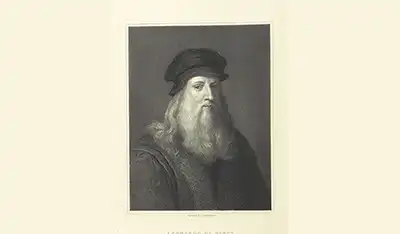
Leonardo da Vinci (1452-1519) was an Italian polymath, known for his diverse range of skills in painting, engineering, science, sculpture, architecture, and theory. He is widely considered to be one of the greatest painters of all time.
Despite being one of the most accomplished and educated men of his time, he had humble origins. He was born in the city of Vinci in Tuscany in 1452 to Caterina, a peasant woman, and Piero, a notary who spent most of his time in Florence. His childhood was spent in the village of Anchiano, outside the center of Vinci, in his grandparents’ home.

His education was quite disorderly and intermittent, without a specific program, and was provided by his grandfather Antonio, his uncle Francesco, and Father Piero, who baptized him. Interestingly, the boy learned to write with both hands, in a way that mirrored normal writing. Vasari, in his book “Le vite de’ più eccellenti pittori, scultori e architettori”, recounts how the young Leonardo began “many things…and then abandoned them” in his studies. As it was impossible to start him on a legal career, his father decided to introduce him to the abacus, an ancient instrument for mathematical operations, despite constantly raising doubts and difficulties for the teacher who taught him.
In 1468, when Leonardo da Vinci was 16, he moved to Florence where he received an apprenticeship with the renowned Florentine painter Andrea del Verrocchio. He learned a variety of skills, including painting, sculpture, metalworking, and drafting.
Leonardo da Vinci’s achievements
Leonardo’s most famous paintings include the Mona Lisa, The Last Supper, and the Virgin of the Rocks. He was also a talented inventor and engineer, and he produced notebooks filled with detailed drawings and plans for flying machines, submarines, and other inventions that were centuries ahead of their time.
Leonardo’s curiosity and thirst for knowledge led him to explore a wide range of subjects, including anatomy, botany, geology, and astronomy. His notebooks are filled with observations, sketches, and theories that reveal his deep understanding of the natural world.
Leonardo da Vinci is considered one of the most important figures in the history of Western civilization. His work as a painter, scientist, and engineer helped to shape the course of the Renaissance and continues to inspire people today.
Leonardo da Vinci’s achievements spanned a wide range of fields, making him a true “Renaissance Man.” Here are some of his most notable accomplishments:
Art
Mona Lisa: Also called “La Gioconda”, this iconic portrait is perhaps the most famous painting in the world. Leonardo’s innovative use of sfumato helped to set this masterpiece apart.

The Last Supper: This mural depicting the final meal Jesus shared with his disciples is another of Leonardo’s most celebrated works.

Vitruvian Man: This drawing perfectly proportions the human body within a circle and square. It is considered a symbol of the ideal Renaissance man.

Science
Anatomy: Leonardo da Vinci created remarkably accurate drawings of the muscles, bones, and organs, advancing the understanding of the human body.



Engineering
Flying machines: Leonardo da Vinci filled his notebooks with sketches and designs for flying machines, including gliders, helicopters, and even a parachute.



Inventions: Leonardo da Vinci’s notebooks contain designs for a variety of other inventions and projects, including a tank, a submarine, and an adding machine.


Leonardo da Vinci Museum in Vinci, Italy
The Leonardo da Vinci Museum in Vinci, Italy, celebrates the life, work, and legacy of the famous polymath. It’s located in Palazzina Uzielli, which was once part of the Castle of the Counts Guidi, overlooking the beautiful Tuscan countryside. The museum offers a wide range of exhibits, including replicas of Leonardo’s machines and inventions, interactive displays, multimedia presentations, and educational programs. It also hosts special events, workshops, and temporary exhibitions. The museum provides visitors with an immersive and educational experience in the heart of Leonardo’s hometown.

Leonardo da Vinci’s work has had a profound impact on Western civilization. His legacy extends far beyond his own time, and his work continues to inspire artists, scientists, and thinkers across disciplines to this day. His combination of artistic brilliance, scientific curiosity, and inventive spirit epitomizes the ideal of the Renaissance polymath.
Bibliography
1 – Leonardo da Vinci – Italian artist, engineer and scientist – https://www.britannica.com/biography/Leonardo-da-Vinci
2 – Leonardo da Vinci – https://en.wikipedia.org/wiki/Leonardo_da_Vinci#
3 – Vida e Obra de Leonardo da Vinci – https://www.todamateria.com.br/vida-e-obra-de-leonardo-da-vinci/


